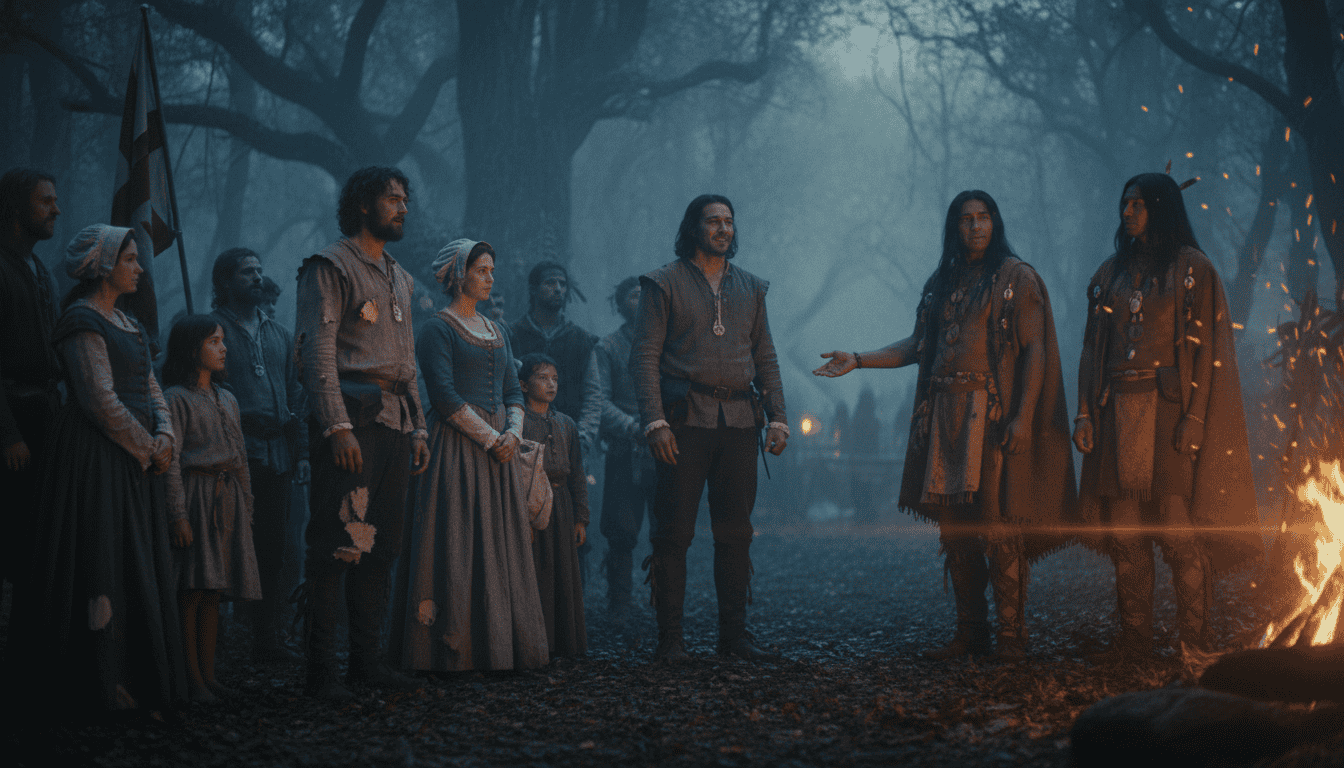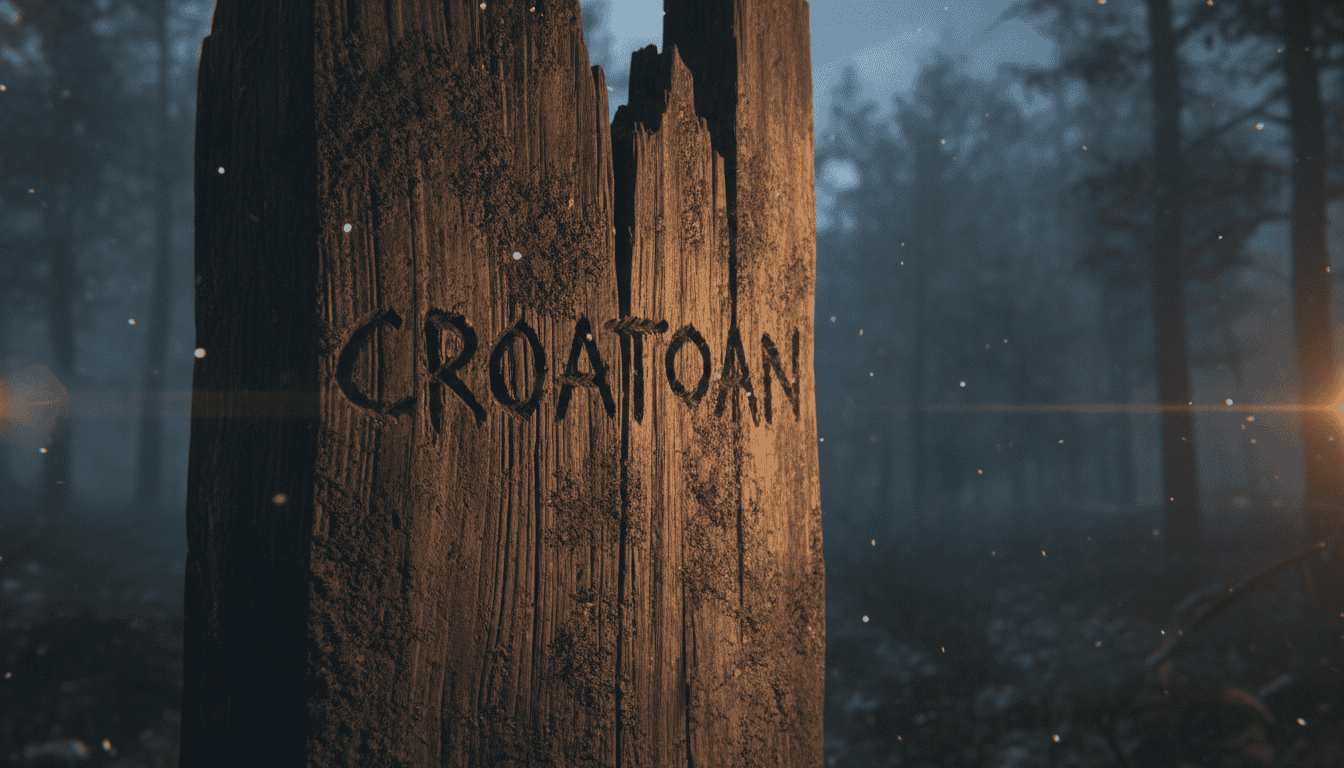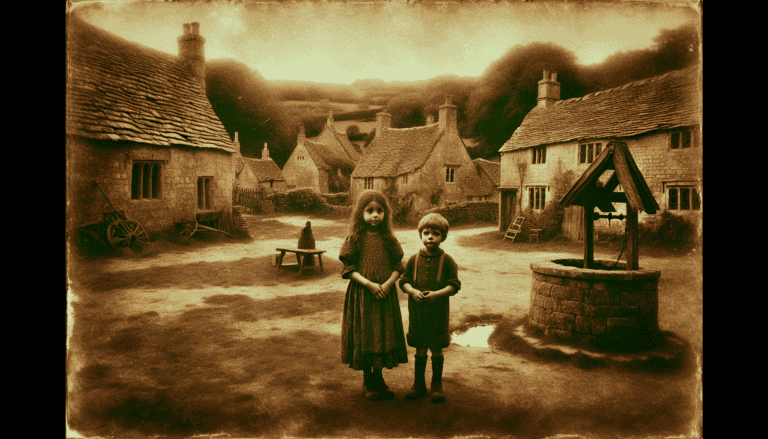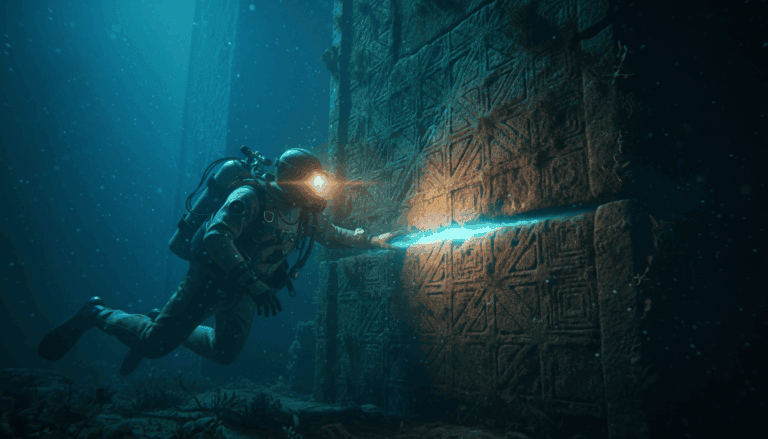CROATOAN: The Enduring Mystery of the Lost Roanoke Colony
One of America’s oldest and most baffling unsolved mysteries begins with hope and ends in eerie silence. In the late 1500s, a group of 117 English men, women, and children established a settlement on Roanoke Island, a remote outpost off the coast of modern-day North Carolina. Within three years, they had all vanished, leaving behind an abandoned fort but no bodies and no signs of a battle. Their sudden disappearance has haunted historians and treasure hunters for centuries, becoming a foundational piece of American folklore.
The search party that arrived in 1590 found the settlement carefully dismantled, not destroyed, suggesting the colonists had not left under duress. Their only clue was a single, cryptic word carved into a wooden post: “CROATOAN.” Nearby, the letters “CRO” were found etched into a tree, but the colonists themselves were gone. Before leaving, their governor had told them to carve a Maltese cross if they were in trouble, but no such distress signal was found, deepening the enigma of their fate.
Key Takeaways
-
In the late 1580s, a group of 117 English settlers, including women and children, vanished from their colony on Roanoke Island, creating one of America’s oldest unsolved mysteries.
-
The only significant clue left at the abandoned settlement was the word ‘CROATOAN’ carved into a post, which was the name of a nearby island and its Native American inhabitants.
-
Evidence suggests the colonists left willingly, as the settlement was carefully dismantled, not destroyed, and a pre-arranged distress signal (a Maltese cross) was notably absent.
-
The leading theory is that the colonists assimilated with the friendly Croatoan tribe for survival after their governor, John White, was delayed in returning with supplies for three years.
-
Modern archaeological finds, such as English pottery mixed with Native American artifacts on Hatteras Island (formerly Croatoan), provide physical evidence supporting the assimilation theory.
-
The colony was intended to be a permanent English settlement, symbolized by the birth of Virginia Dare, the first English child born in the Americas, who disappeared with the rest of the colonists.
A Voyage to a New World
In the summer of 1587, a determined group of over 100 English settlers landed on the shores of Roanoke Island, off the coast of what is now North Carolina. This expedition, led by artist and newly appointed governor John White, was different from previous attempts because it included women and children with the goal of establishing a permanent English colony. Filled with hopes for a prosperous new life, they began the difficult work of repairing the fort and cottages left by an earlier military party. The colonists were intent on building a true community, a lasting foothold for England in the Americas.
A month after their arrival, a powerful symbol of this new beginning appeared within the small settlement. On August 18, 1587, Governor White’s daughter, Eleanor Dare, gave birth to a healthy baby girl. Named Virginia Dare, she holds the historic title of being the first English child born in the New World. Her birth was a celebration and a sign that the colonists were putting down roots. This small child represented the future of the colony and the reason these families had risked everything for a chance at a new life across the ocean.
An Urgent Trip and a Long Delay

Despite the initial hope, the colonists’ situation quickly grew desperate. Their supplies were dangerously low, and their relationship with some local tribes was already strained, making them dependent on a resupply from home. The settlers pleaded with Governor John White to sail back to England for crucial provisions, tools, and reinforcements. He reluctantly departed in late August 1587, leaving behind his entire family, including his newborn granddaughter Virginia Dare, with the solemn promise of a swift return the following spring.
What should have been a journey of a few months spiraled into an agonizing three-year delay. When White arrived back in England, he found a nation in a panic, preparing for an all-out war with the massive Spanish Armada. According to government records from the time, Queen Elizabeth I issued a stay on all shipping, commandeering every able vessel for the defense of the realm. Every desperate attempt White made to secure a ship and crew for his return to Roanoke was denied, leaving him stranded an ocean away as the fate of his colonists hung in the balance.
The Eerie Silence of an Empty Fort
When Governor John White finally set foot back on Roanoke Island in August 1590, he found an unnerving silence where a bustling settlement once stood. The small village was gone, with houses and structures carefully dismantled, not violently destroyed. According to White’s own journal, his men found several of his chests, which had been buried for safekeeping, broken open and their contents scattered by the elements. There were no human remains, no skeletons, and no signs of a battle or struggle, only an empty space that once held the hopes of 117 people.
The search party’s hope flickered to life when they discovered a single, cryptic clue. Carved into a wooden post of the fort’s palisade was one word: “CROATOAN.” This was a significant finding, as Croatoan was the name of a nearby island (now Hatteras Island) and the Native American tribe who lived there. Before his departure, White had instructed the colonists that if they had to move, they should carve their destination into a tree or post. He also told them to carve a Maltese cross above the name if they were in distress, but no such cross was found, suggesting the colonists had left their settlement willingly.
Searching for the Lost Colonists

The most compelling theory stems directly from the single word carved into the fort’s post: “CROATOAN.” This was not a random word, but the name of a nearby island and the Algonquian tribe that lived there, led by Chief Manteo. These people were known to be friendly with the English colonists, and the carving lacked the Maltese cross that would have signaled distress. Governor White had planned to sail to Croatoan to investigate, but a violent storm forced his ships back to sea, leaving the clue unexplored. This suggests the colonists may have left their settlement to seek refuge with their allies.
For centuries, the Croatoan theory was speculation, but modern archaeology is adding weight to the idea of assimilation. Researchers with the First Colony Foundation have unearthed compelling evidence, such as English pottery mixed with Native American artifacts at a site on Hatteras Island, the former Croatoan. Further inland, at a location known as Site X, archaeologists have found more 16th-century European items, suggesting a small group may have moved with a friendly tribe. These discoveries suggest a story of survival through integration, one of two cultures merging in the face of hardship.
While the assimilation theory is strong, other explanations for the colony’s disappearance persist. Some historians propose that the colonists were attacked and wiped out by a hostile tribe, perhaps the Spanish-allied Secotan, though evidence for a large-scale massacre is lacking. Another possibility is that the group split up, with some attempting a perilous journey north toward the Chesapeake Bay to find a more suitable location. Without a definitive account or a clear gravesite, the fate of the Roanoke settlers remains a puzzle with several possible, yet unproven, solutions.
A Four-Hundred-Year-Old Question
For over four centuries, the fate of the Roanoke colonists has remained one of America’s most persistent historical riddles. The single word “CROATOAN” carved into a post offers the most substantial clue, suggesting the settlers relocated to the nearby island inhabited by a friendly Algonquian tribe. Archaeological evidence, like the discovery of English pottery shards mixed with native artifacts on Hatteras Island (formerly Croatoan), lends weight to this theory of assimilation. This idea suggests a story not of a violent end, but of survival through integration with their new neighbors. Yet, without a definitive account or a gravesite, this explanation remains a well-supported theory rather than a historical fact.
The search for answers continues, with historians and archaeologists still combing the North Carolina coast for proof. Each new discovery, from map notations to pottery fragments, adds another piece to the puzzle, but none has fully solved it. Other, more dramatic theories persist, ranging from a fatal clash with a different tribe to a desperate, failed attempt to sail back to England. The story of the Lost Colony captures our imagination because its ending is unwritten, forcing us to confront the thin line between historical record and speculation.
The silence from Roanoke Island has allowed countless theories to flourish, each attempting to fill the void left by the missing colonists. Could they have blended into a new culture, their English identities fading over generations, or did a more tragic, unrecorded event seal their fate? The mystery is as much about the available evidence as it is about what is missing from the historical record. Now that you’ve seen the clues, what do you think happened to the men, women, and children of the Roanoke Colony?
Conclusion
The disappearance of the Roanoke Colony remains one of America’s most haunting unsolved mysteries. Governor John White’s return in 1590 to an empty fort and a single, cryptic word carved into a post set the stage for centuries of speculation. The absence of bodies or signs of a struggle has allowed theories to multiply, from a devastating attack to a desperate migration, yet none can fully explain the fate of the 117 men, women, and children.
Many historians and archaeologists now lean toward the explanation that the colonists went to live with the Croatoan people. This theory is directly supported by the clue John White discovered, which notably lacked the Maltese cross that would have signaled danger. Governor White himself intended to search Croatoan Island, which is modern-day Hatteras, but was thwarted by a dangerous storm that forced his fleet back to England. Recent archaeological discoveries of English-style pottery mixed with Native American artifacts in the area lend tantalizing, though not conclusive, support to this idea of peaceful assimilation.
More than four centuries later, the story of the Lost Colony continues to capture the imagination because it speaks to the uncertainties of the past. The tale of Virginia Dare, a symbol of new beginnings, ending in a question mark is a powerful and enduring American narrative. It is a reminder of the challenges faced by early explorers and the thin line between hope and disaster in a new world. While the trail has gone cold, the single word “CROATOAN” echoes through history, leaving us to wonder if it was a simple message of relocation or a clue to a much darker secret.
Frequently Asked Questions
1. What was the ‘Lost Colony of Roanoke’?
The Lost Colony was a group of 117 English men, women, and children who settled on Roanoke Island in 1587. They aimed to establish England’s first permanent settlement in the Americas. Within three years, the entire community vanished, sparking one of America’s oldest and most haunting unsolved mysteries.
2. What happened to the 117 colonists?
Sometime between 1587 and 1590, the entire population disappeared without leaving a clear explanation. When a search party returned, they found an empty and dismantled settlement but no bodies or signs of a battle. The colonists’ fate remains unknown.
3. What is the meaning of the word ‘CROATOAN’?
The word ‘CROATOAN’ was the only significant clue found at the abandoned settlement, carved into a wooden post. This was the name of a nearby island and the Native American tribe that lived there. This cryptic message has led many to theorize the colonists relocated and perhaps assimilated with the local people.
4. Were the colonists attacked or in distress?
The evidence suggests the colonists did not leave in a panic or under attack. The settlement was found carefully dismantled, not destroyed. Additionally, the pre-arranged distress signal, a Maltese cross, was not carved, indicating they may have left willingly.
5. Who was Virginia Dare?
Virginia Dare was the first English child born in the Americas, on August 18, 1587. As the granddaughter of Governor John White, her birth was a powerful symbol of hope for the new colony. She disappeared along with all the other settlers, becoming a key figure in the legend.
6. Where was the Roanoke settlement located?
The colony was established on Roanoke Island, a remote outpost situated off the coast of what is now North Carolina. The settlers began their new life by repairing a fort and cottages that had been left behind by an earlier English military party.
7. Why was this colony different from previous attempts?
This expedition was a dedicated attempt to build a permanent, lasting community, not just a military outpost. The inclusion of women and children, including Governor White’s own daughter and granddaughter, showed a clear intention to put down roots and create an English society in the New World.





